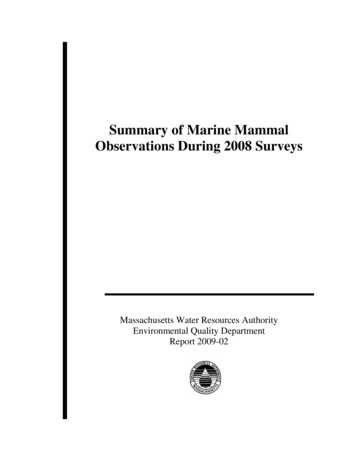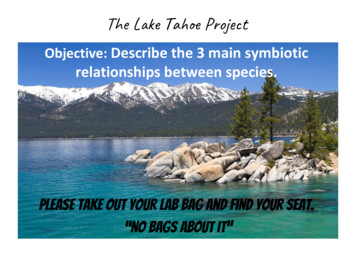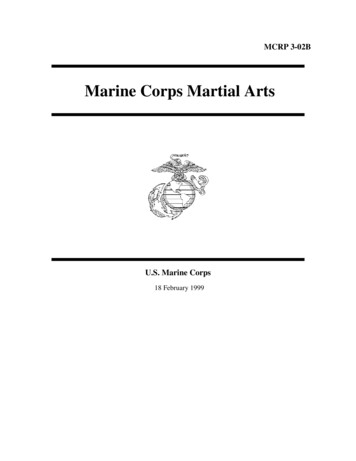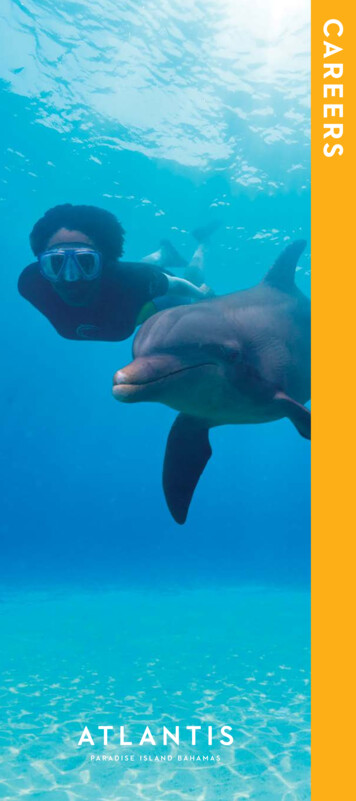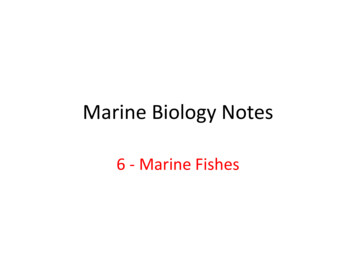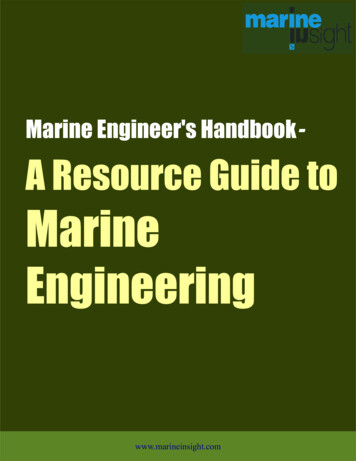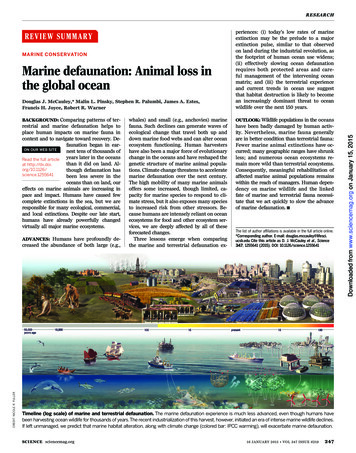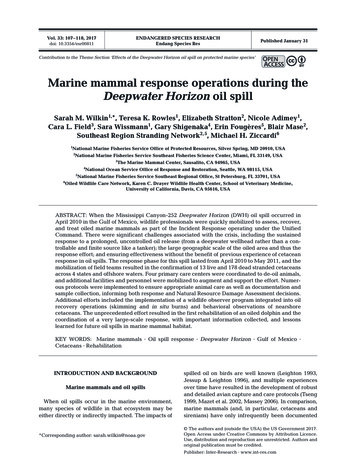
Transcription
Vol. 33: 107–118, 2017doi: 10.3354/esr00811ENDANGERED SPECIES RESEARCHEndang Species ResContribution to the Theme Section ‘Effects of the Deepwater Horizon oil spill on protected marine species’Published January 31OPENACCESSMarine mammal response operations during theDeepwater Horizon oil spillSarah M. Wilkin1,*, Teresa K. Rowles1, Elizabeth Stratton2, Nicole Adimey1,Cara L. Field3, Sara Wissmann1, Gary Shigenaka4, Erin Fougères5, Blair Mase2,Southeast Region Stranding Network2, 5, Michael H. Ziccardi61National Marine Fisheries Service Office of Protected Resources, Silver Spring, MD 20910, USA2National Marine Fisheries Service Southeast Fisheries Science Center, Miami, FL 33149, USA3The Marine Mammal Center, Sausalito, CA 94965, USA4National Ocean Service Office of Response and Restoration, Seattle, WA 98115, USA5National Marine Fisheries Service Southeast Regional Office, St Petersburg, FL 33701, USA6Oiled Wildlife Care Network, Karen C. Drayer Wildlife Health Center, School of Veterinary Medicine,University of California, Davis, CA 95616, USAABSTRACT: When the Mississippi Canyon-252 Deepwater Horizon (DWH) oil spill occurred inApril 2010 in the Gulf of Mexico, wildlife professionals were quickly mobilized to assess, recover,and treat oiled marine mammals as part of the Incident Response operating under the UnifiedCommand. There were significant challenges associated with the crisis, including the sustainedresponse to a prolonged, uncontrolled oil release (from a deepwater wellhead rather than a controllable and finite source like a tanker); the large geographic scale of the oiled area and thus theresponse effort; and ensuring effectiveness without the benefit of previous experience of cetaceanresponse in oil spills. The response phase for this spill lasted from April 2010 to May 2011, and themobilization of field teams resulted in the confirmation of 13 live and 178 dead stranded cetaceansacross 4 states and offshore waters. Four primary care centers were coordinated to de-oil animals,and additional facilities and personnel were mobilized to augment and support the effort. Numerous protocols were implemented to ensure appropriate animal care as well as documentation andsample collection, informing both response and Natural Resource Damage Assessment decisions.Additional efforts included the implementation of a wildlife observer program integrated into oilrecovery operations (skimming and in situ burns) and behavioral observations of nearshorecetaceans. The unprecedented effort resulted in the first rehabilitation of an oiled dolphin and thecoordination of a very large-scale response, with important information collected, and lessonslearned for future oil spills in marine mammal habitat.KEY WORDS: Marine mammals · Oil spill response · Deepwater Horizon · Gulf of Mexico ·Cetaceans · RehabilitationINTRODUCTION AND BACKGROUNDMarine mammals and oil spillsWhen oil spills occur in the marine environment,many species of wildlife in that ecosystem may beeither directly or indirectly impacted. The impacts of*Corresponding author: sarah.wilkin@noaa.govspilled oil on birds are well known (Leighton 1993,Jessup & Leighton 1996), and multiple experiencesover time have resulted in the development of robustand detailed avian capture and care protocols (Tseng1999, Mazet et al. 2002, Massey 2006). In comparison,marine mammals (and, in particular, cetaceans andsirenians) have only infrequently been documented The authors and (outside the USA) the US Government 2017.Open Access under Creative Commons by Attribution Licence.Use, distribution and reproduction are unrestricted. Authors andoriginal publication must be credited.Publisher: Inter-Research · www.int-res.com
108Endang Species Res 33: 107–118, 2017as being affected during oil spill incidents, resultingin less extensive readiness capabilities and ‘wildliferesponse’ efforts during spills.Geraci & St. Aubin (1990), Jessup & Leighton (1996),and Johnson & Ziccardi (2006) summarized the littlethat was known about the effects of oil on cetaceansprior to the MC-252/Deepwater Horizon (DWH) oilspill in 2010. Early behavioral studies conducted withcaptive cetaceans indicated that they were able todetect and actively avoid oil slicks on the surface ofthe water (Smith et al. 1983, Geraci 1990). However,observations in actual spills in the marine environment have demonstrated that larger whales (bothmysticetes and odontocetes) and smaller delphinidsdo not avoid oil, with observations of animals traveling through and feeding in oil slicks (Grose & Mattson 1977, Goodale et al. 1979, Matkin et al. 1994,Smultea & Wursig 1995, Aichinger Dias 2017, thisTheme Section).While sightings of cetaceans during oil spills havebeen limited, and generally from aircraft, assessmentof the physiological and toxicological impacts oreffects of spills on marine mammals has been virtually nil. Prior to DWH, focused efforts to find, recover,and investigate stranded cetaceans in the vicinity ofan oil spill were very limited. Without such effort inresponse, it has been difficult to determine if theseanimals were oiled or compromised due to the oil,limiting our understanding of impacts of oil and thepotential mitigation measures that could be implemented during a response. Generally, only small numbers of cetaceans have been opportunistically foundstranded coincident with oil spills (summarized byGeraci 1990 for spills prior to 1990; see also MMS1983, Harvey & Dahlheim 1994, Loughlin 1994, Zimmerman et al. 1995, Ozturk 2002).For sirenians, even less experimental or anecdotalinformation is available, with only scant reports of impacts on manatees and dugongs (Loritz 1991, FigueroaOliver et al. 2000). For example, during the Iran–Iraqwar in 1983, 53 dugong carcasses were recovered, butno detailed examinations of the carcasses were conducted (St. Aubin & Lounsbury 1988). Overall, the impact of oil on sirenians is largely unknown (O’Hara &O’Shea 2001) and, outside of these few anecdotal reports, no information is available on the pathophysiology and toxicology of oil exposure in sirenians.Marine mammals in the Gulf of MexicoTwenty-one species of cetaceans and 1 species ofsirenian are found in the northern Gulf of Mexico(GoM), with 2 (sperm whale Physeter macrocephalusand West Indian manatee Trichechus manatus) currently listed as endangered under the US Endangered Species Act, triggering additional US regulatory protections. Reports of marine mammals in theGoM that are sick, injured, out of habitat, in distress,or dead (‘stranded’) are responded to by organizations within defined marine mammal strandingnetworks, administered separately by the NationalOceanic and Atmospheric Administration’s NationalMarine Fisheries Service (NOAA/NMFS) for cetaceans and the US Fish and Wildlife Service (USFWS)for manatees.The Marine Mammal Health and Stranding Response Program (MMHSRP), which was formalizedin the 1992 Amendments to the Marine MammalProtection Act (MMPA), is operated by NMFS toaddress concerns related to marine mammal healththrough national program components and regionalimplementation. The NMFS Regional StrandingNetwork in the GoM consists of volunteer networkmember organizations, including state agencies,non-profit organizations, academic institutions, andfederal laboratories that are organized, authorized,and administered through Stranding Agreementsissued by NMFS’s Southeast Regional Office (orother authorizations for government agencies) andcoordinated by the NMFS Southeast Fisheries Science Center in Florida. Trained network partnersrespond to and investigate live or dead strandedcetaceans, with some organizations providing rehabilitation for sick or injured cetaceans. In the northern GoM (Louisiana to the Florida Panhandle) at thetime of the DWH oil spill, 5 primary organizationswere responsible for stranding response within defined geographic areas; organizations typically workindependently and only in their geographic area.The 2005 2009 annual average of cetacean strandings in the northern GoM region was 54 animals yr 1,with over 95% reported dead at time of stranding,and bottlenose dolphins representing 87% of thetotal (Venn-Watson et al. 2015).For manatees, the USFWS has operated the Manatee Rescue and Rehabilitation Partnership (MRP)since 1973. Response effort for live and dead manatees has historically focused on primary manateehabitat in Florida. The 2005 2009 annual averagefor manatee responses throughout the United Stateswas approximately 80 rescues of live animals(USFWS Manatee Database unpubl. data) and 350recoveries of carcasses (FWC Mortality Databaseunpublished data), the vast majority of them inFlorida.
Wilkin et al.: DWH marine mammal response operationsEarly DWH response (20 April to 31 May 2010)Wildlife BranchWithin the first week of the DWH response, a Wildlife Branch was activated within the Incident Command Post (ICP) established in Houma, Louisianaa109(LA) (Fig. 1a). In consultation with NMFS (and for thefirst time in US oil spill efforts), a designated MarineMammal and Sea Turtle Group (further divided intothe Marine Mammal Unit [MMU] and the Sea TurtleUnit) was created within the Wildlife Branch, operationally separate from the other groups within theWildlife Branch, namely Bird Stabilization/Rehabilita-Unified Area CommandEstablished April 20, 2010Robert, LAIncident Command PostEstablished April 23, 2010Houston, TXIncident Command PostEstablished April 23, 2010Houma, LAIncident Command PostEstablished April 26, 2010Mobile, ALIncident Command PostEstablished July 9, 2010Galveston, TXIncident Command PostEstablished end May, 2010Miami, FLPrimarily responsiblefor capping the wellheadResponsible for fieldoperations in LouisianaResponsible for fieldoperations in Mississippi,Alabama, and FloridaPanhandleResponsible for fieldoperations in Texas(Anticipation of oilspread to TX – actualeffort minimal)Responsible for fieldoperations in peninsularFlorida (Anticipation of oilspread to FL – actualeffort minimal)bFOSC(USCG)RPICOperations SectionRecovery andProtection BranchOn-Water Recovery(Skimming) UnitIn situ Burn UnitShoresideRecovery UnitProtection(Booming) UnitPublic Information OfficerJoint Information Center (JIC)SOSCFinance SectionWildlife BranchAir OperationsBranchUnified AreaCommandMarine Mammal UnitWildlifeReconnaissance UnitLogistics SectionVesselSupport UnitVessels ofOpportunity(VOO) ProgramPlanning SectionSituation hniquesBird Searchand Collection UnitBird Stabilization/Rehabilitation UnitSea Turtle UnitFig. 1. Incident Command structure implemented for the Deepwater Horizon oil spill response. (a) Unified Area Command and5 Incident Command Posts were established to divide the response geographically. LA: Louisiana; TX: Texas; AL: Alabama;FL: Florida. (b) Simplified Incident Command structure within each Incident Command Post, following the US Coast Guard(USCG) Incident management handbook, with expanded focus on the Wildlife Branch and groups that interacted withthe Marine Mammal Unit. FOSC: Federal Onscene Coordinator; RPIC: Responsible Party Incident Commander; SOSC: StateOnscene Coordinator
Endang Species Res 33: 107–118, 2017110tion, Bird Search and Collection, and Wildlife Reconnaissance Units (Fig. 1b). Despite the later establishment of multiple ICPs for local management of activities (Fig. 1a), the MMU made the tactical decision toremain organized as a single unit managed from asingle location, based in Houma, LA, with a marinemammal expert placed in the largely bird-centricWildlife Branches in each additional ICP.Personnel from the University of California at Davis(UCD), in collaboration with the MMHSRP, had developed National Guidelines for Oiled Marine MammalResponse (National Guidelines; Johnson & Ziccardi2006), and this document was used as the basis for initial guidance, as well as the overall marine mammalresponse plan. The MMU rapidly developed specificprotocols for guiding experienced marine mammalresponders with no prior oil spill experience, and forestablishing efficient means of receiving reports ofstranded marine mammals. A toll-free wildlife hotlinewas quickly established by the Unified Area Command(UAC) and widely promoted to responders, membersof the public, and the media as a rapid mechanism forreporting any species of stranded or distressed wildlifein the northern GoM. The hotline was manned daily(from at least 06:00 to 18:00 h), information recordedon a standardized form, and immediately relayed to theMMU. Data were typically passed to the local stranding network organization within 30 min of receipt.MMU activitiesThe initial reporting of marine mammals involvedin the DWH spill began on 30 April 2010. Operationalquestions that arose in this early response phase, andthe initial approach taken, included the following:(1) How could marine mammal response best beincorporated into overall Wildlife Branch operations?A Wildlife Management Plan was prepared for theincident and submitted to the UAC on 10 May 2010.This plan outlined the responsible authorities, organization of the Wildlife Branch, and general operationalguidance at a high level for all impacted wildlife taxa,and incorporated the NOAA-NMFS National Guidelines to direct the response to, and care of, any affectedmarine mammals independent of, but in coordinationwith, bird response. The guidelines were significantlyrevised throughout the response to include manateesand further guidance on cetaceans.(2) What should the geographic response area befor potentially impacted marine mammals?Cetaceans are highly mobile at sea. As such, marine mammals (unlike birds) impacted within an oilslick may continue to swim and eventually strand ina location some distance away. Trajectory modelswere examined to estimate the extent of the oil slick,and a buffer zone extending beyond the oil boundarywas applied to account for marine mammal movements post-oiling. The Designated Response Area(DRA) was initially defined as the Texas/Louisianaborder eastward to the Alabama/Florida border, butwas quickly expanded to include the Florida panhandle eastward to Apalachicola based on oil trajectoryevaluation. Planning and preparatory activities tookplace outside the DRA, but strandings from theseareas were not considered to be part of the officialDWH response (see Table 2).(3) What health and safety training should marinemammal field response and facility workers have?The 24 h Hazardous Waste Operations and Emergency Response (HAZWOPER) training was deemednecessary for field workers but not required for facility (rehabilitation and necropsy) workers. The requirement for field workers was a significant consideration in mobilizing personnel, as most members ofthe marine mammal stranding network were nottrained at this level at that time. Given the need toincorporate additional personnel but also satisfymandated safety requirements, the Safety Officerarranged to have a HAZWOPER equivalency course(3 h) offered online.(4) What resources (personnel, equipment, supplies, and facilities for recovery and rehabilitation oflive and dead animals) are appropriate and availablefor marine mammal response?Pre-existing and authorized marine mammal stranding network organizations in the northern GoM weremobilized in 1 of 2 roles: primary care (cleaning andrehabilitating oiled marine mammals) and field response (collecting animals from the field and transporting them to a primary care facility or necropsylaboratory; Table 1). Additionally, organizations withmanatee expertise outside of the DRA were placed inan on-call status in the event that manatees wereimpacted. Finally, stranding network partners outside the northern GoM were identified to serve assecondary facilities that could complete the longterm rehabilitation of cetaceans following their deoiling and stabilization at a primary care facility. Toprepare for increased needs (including personnelrotations to address fatigue), lists of additional personnel were also compiled from stranding partnersoutside the GoM, zoos, academia, and aquariums.Important contingency needs were identified, including additional temporary holding pools, increasingwash capabilities within permanent facilities, field
Wilkin et al.: DWH marine mammal response operations111Table 1. Marine mammal response organizations and care facilities activated for the Deepwater Horizon oil spill; na: notapplicableNameLocationGeographic response coverageNew Orleans, LouisianaLouisianaPrimary care (cleaningof oiled mammals)RehabilitationNecropsyThroughout LouisianaLouisianaField responseGulfport, MississippiMississippi and AlabamaPrimary careRehabilitationNecropsyField responseGulfWorld Marine ParkPanama City Beach, FloridaFlorida PanhandlePrimary careRehabilitationNecropsyField responseEmerald Coast Wildlife RefugeFort Walton Beach, FloridaFlorida PanhandleField responseOrlando, FloridaOn callField response (manatees)Rehabilitation (manatees)Throughout FloridaOn callField response (manatees)Homosassa Springs, FloridanaRehabilitation (manatees)Lowry Park ZooTampa, FloridanaRehabilitation (manatees)Miami SeaquariumMiami, FloridanaRehabilitation (manatees)Audubon Aquarium ofthe AmericasLouisiana Department ofWildlife and FisheriesInstitute for MarineMammal StudiesSeaWorld OrlandoFlorida Fish and WildlifeConservation CommissionHomosassa Springs State Parkequipment for transporting both live and dead mammals, and augmenting capacity to conduct full necropsies/sampling from all collected animals (includingstorage of carcasses/samples and collection of internal and external evidentiary samples).(5) What were the appropriate, legally binding protocols for sample handling, collection, and storage(including chain of custody), as well as active surveillance for affected mammals?The revised National Guidelines included cetaceanrecovery, rehabilitation, and sample and evidencecollection procedures, as well as intake, care, necropsy,and chain of custody data forms. Significant effortswere made to physically confirm all reports of strandings. Responders examined animals and collectedswab samples to detect external oiling or oil trappedin external orifices (e.g. mouth, blowhole, perinealarea), and carcasses were collected and transportedto laboratories, as logistically possible, for necropsyand further sampling. Live-stranded marine mammals that were evaluated on the beach by strandingnetwork members were either transported to rehabilitation, immediately released, or humanely euthanized, depending upon the medical condition. Liveanimals that died on the beach, in transport, or inrehabilitation were necropsied and sampled.Role(6) How should efforts be coordinated to collect theappropriate data on marine mammal sightings, behavior, clinical findings, and other information forresponse needs and also for use within the NaturalResource Damage Assessment (NRDA)?Reconnaissance and Hotline data were used forresponse purposes and were also provided to themarine mammal NRDA Technical Working Group(TWG). Data forms and protocols were provided forNRDA review to confirm that data were being collected that would inform the NRDA/TWG efforts. Itshould be noted that the NRDA is a US legal requirement under the Oil Pollution Act. Similar post-spillecological assessments may be conducted in othercountries, and references to NRDA should be interpreted broadly in the international context.(7) How would data be transmitted internally withinthe Incident Command System (ICS) and externallyto the media (via the Joint Information Center) andother interested parties?All marine mammals confirmed stranded withinthe DRA were documented in daily reports providedto the UAC. Animals were categorized as ‘visiblyoiled’ (having evidence of oil externally or internally,including at necropsy for dead animals), ‘not visiblyoiled’ (no evidence of oil externally or internally), or
Endang Species Res 33: 107–118, 2017112‘pending’ (cases that had not received a thoroughexamination upon recovery, or had not yet beennecropsied). Once the examination of a ‘pending’animal had been completed, animals were thenmoved to either ‘visibly oiled’ or ‘not visibly oiled’category. Oiling status did not define cause of death,or indicate that the animal had or had not beenimpacted by the spill; the classification meant merelywhether or not oil could be observed at the time ofthe examination.Animal summary for the early DWH time periodFrom the beginning of marine mammal responseoperations on 30 April 2010 through 31 May 2010, 34dead cetaceans were responded to, with 1 confirmedas being visibly oiled (Table 2). No live marine mammals were confirmed stranded during this initialresponse period.Intermediate DWH response(1 June to 31 August 2010)All marine mammal response efforts noted abovecontinued during this time period, but with someadditions as outlined in this section. A modified version of the marine mammal National Guidelines specific to the DWH spill was released to responders on10 June 2010.Wildlife observersAs the extent of clean-up operations expanded,concerns began to be raised regarding the potentialfor harassment, injury, and death of wildlife from onwater oil recovery activities — specifically in situ burning and skimming. As a result, specialized wildlife observers were hired, trained, and coordinated out ofthe Wildlife Branch providing observations and response for sea turtles, birds, and marine mammals. On21 June 2010, an initial observer was placed withinthe in situ burn operations for a feasibility test thatwas deemed successful based upon the ability of theobserver to become integrated into and monitor theoperations. By 9 July 2010, enough observers hadbeen deployed with the in situ burn task forces to provide 100% coverage for each ignition. Observers surveyed the area of the burn prior to oil collection, examined the area within the burn boom to ensure thatno animals were contained within it, and continued tosurvey the surrounding area during and immediatelyfollowing the burn. Observers were also placed on25% of offshore skimming vessels, focusing on thosevessels that represented the greatest risk to wildlife,either by virtue of their mode of operation or the areain which they were working. Observers on these tripssurveyed the area around the skimming vessel as wellas the oil inside the boom to ensure that there were noanimals there, and were equipped and prepared todocument all and rescue most animals in need of assistance. No marine mammals were observed withinTable 2. Live and dead cetacean strandings under the Deepwater Horizon (DWH) oil spill response; numbers reported aslive dead. VO: visibly oiled; NVO: not visibly oiled; blank cells indicate areas/times in which strandings were not considered tobe part of the official DWH response activities; no manatee strandings occurred as part of official DWH response activitiesApr 2010May 2010Jun 2010Jul 2010Aug 2010Sep 2010Oct 2010Nov 2010Dec 2010Jan 2011Feb 2011Mar 2011Apr 2011May 2011TotalGrand PanhandleVONVOVONVOOffshoreVONVO0 00 10 10 00 11 00 00 00 10 10 30 10 00 01 90 00 00 10 00 00 00 00 00 00 80 50 60 30 10 30 00 00 00 00 00 00 00 00 00 00 31 20 10 00 20 00 00 00 01 00 00 00 00 00 00 00 02 10 01 00 20 00 00 00 00 00 00 00 00 00 00 00 00 10 01 00 00 00 00 10 260 01 81 03 30 01 10 00 221 110 11 120 110 20 01 32 70 190 180 141 106 1307 1390 271 84 31 1VOTotalNVO0 00 00 10 331 24 200 00 80 13 151 00 160 00 50 00 00 11 30 12 70 30 190 10 180 00 140 01 102 10 11 16813 178
the in situ burn booms or in proximity to the skimming vessel, andno rescues of any wildlife wereconducted by these offshore observers. Data collected by theseobservers on sightings of animalswere routinely provided to theWildlife Branch.Rehabilitation of oiled cetaceansThe first live dolphin strandingoccurred in the DRA on 2 June2010. In total, 13 live-strandeddolphins representing 3 specieswere recovered under response(10 bottlenose dolphins Tursiopstruncatus, 2 spinner dolphins Stenella longirostris, and 1 Clymenedolphin S. clymene; Table 3). Inmost cases, the dolphins werefound isolated on or near a beachand unable or unwilling to swimaway. Some of the live-strandedanimals were immediately released at the site by trained responders after assessing the situation (n 3) or by members ofthe public without assessment(n 2), and several either died(n 4) or were euthanized (n 1)after stranding. Three bottlenosedolphins rescued during response, including one that wasexternally visibly oiled, werebrought into rehabilitation to theAudubon Aquarium of the Americas in Louisiana.For all live-stranded cetaceansencountered by responders, initial clinical assessment was carried out in the field by a veterinarian. As potential exposure tooil was most likely to have occurred through inhalation, aspiration, ingestion, and/or directcontact, particular attention wasdirected to the respiratory andoral tracts, as well as the eyesand skin. Oil on animals wassampled in the field prior toexcessive handling.SpeciesS. longirostrisS. longirostrisT. truncatusT. truncatusS. clymeneT. truncatusT. truncatusT. truncatusT. truncatusT. truncatusT. truncatusT. truncatusT. truncatusNMFSRegional lingYearlingAge litationoutcomeTransferredto rehab.Euthanized at siteImmediaterelease at siteTransferredto rehab.Immediaterelease at siteImmediaterelease at siteObserved 50 km offshore onSargassum mat; path created throughmat to allow animal to swim off;observed to return, and left at sitePushed back into water bymembers of the public against thedirection of trained respondersDolphin observed ‘trapped’between 2 oil booms; animal wouldnot pass under boom; boom wasopened and animal swam outNotesDeemednon-releasablenaPushed back into water by spillresponders prior to contacting trainedrespondersnaAssessed by trained respondersand returned to water; observed torejoin dolphin pod just offshoreDeemednon-releasablenanaTransferredDied in rehab.to rehab.12/15/2010Died at sitenaDied during transportnaLeft at sitenaDied at siteDied at siteImmediaterelease at siteResponseoutcomeTable 3. Details of live cetacean strandings under the Deepwater Horizon oil spill response; NMFS: National Marine Fisheries Service. M: male; F: female; Unk:unknown. Dates are given as mo/dd/yy. Rehab.: Rehabilitation; S.: Stenella; T.: Tursiops; FL: Florida; AL: Alabama; LA: Louisiana; na: not applicableWilkin et al.: DWH marine mammal response operations113
114Endang Species Res 33: 107–118, 2017Generally, the live-stranded dolphins that wereevaluated were lethargic and mildly to moderatelydehydrated, consistent with most stranded cetaceans(Table 3). Blood was collected for routine completeblood count, serum chemistry analysis, and hydrocarbon evaluation, with basic chemistry and electrolyteparameters evaluated in the field with a point-of-careanalyzer whenever possible. Treatment to correctelectrolyte or other abnormalities was initiated in thefield, when possible, in order to help stabilize the animal. Respiratory rate and quality, heart rate, vocalizations, and general movement were evaluated toassess response to handling and potential transport.Mild sedation with a benzodiazepine was requiredfor 2 dolphins due to increased agitation associatedwith transport. Transport occurred either on an openflatbed truck or enclosed vehicle. Air temperatureand movement in enclosed vehicles was controlledwith high cool air flow and open windows to ensureadequate ventilation and appropriate temperaturemaintenance of suspected oiled animals.One live-stranded dolphin (SER10-0610) was visibly oiled and required external de-oiling at the rehabilitation facility. Visible oil covered nearly the entireexternal surface and was concentrated around theanal and genital slits. No oil was visible in the blowhole, mouth, or eyes. The dolphin was cleaned priorto placement in a pool to minimize contamination ofthe facilities. A liberal amount of vegetable oil wasapplied to the entire skin surface to loosen the thick,sticky crude oil, which was then readily wiped offwith absorbent, disposable towels. The skin was thenwashed with a liberal amount of Dawn (Proctor andGamble) liquid detergent and rinsed with fresh waterbefore placing the dolphin in the saltwater rehabilitation pool. Feces were monitored by cytology for thepresence of oil for the first day; however, no visibleevidence of oil in the feces was noted.For each of the 3 dolphins that underwent rehabilitation during response (SER10-0436, SER10-0610,and SER11-0115), further clinical evaluation and sampling for oil contamination was conducted on-site atthe rehabilitation facility, and included evaluation ofexhalation (chuff) samples, gastric fluid, and feces foroil contamination, parasites, and other anomalies.Thoracic radiographs of SER10-0610 were collectedwithin the first few days following stranding, as pneumonia secondary to oil inhalation or other disease process was a concern; the other 2 dolphins were not radiographed. Visual examination of the blowhole andthe blowhole cytology did not show evidence of oilingat the time of stranding in any of the 3 dolphins, andthe dolphins exhibited no clinical findings that re-quired specific respiratory treatments while in rehabilitation. Two of the 3 dolphins undergoing rehabilitation were suspected to have gastrointestinal distressbased on gastric sample cyto
5 Incident Command Posts were established to divide the response geographically. LA: Louisiana; TX: Texas; AL: Alabama; FL: Florida. (b) Simplified Incident Command structure within each Incident Command Post, following the US Coast Guard (USCG) Incident management handbook, with expanded focus on the Wildlife Branch and groups that interacted with
